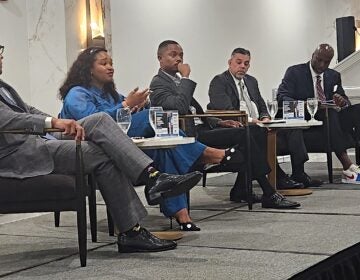Tale of two cities: Poverty in Camden ebbs, Philly rate stays flat

Census data show that poverty in Camden (foreground)is ebbing, while across the river in Philadelphia, the poverty rate remains flat. (Emma Lee/WHYY, file)
Census data released Thursday show that the city of Camden — one of South Jersey’s poorest communities — may be on the rise.
In 2015, 40.5 percent of Camden’s roughly 74,000 residents lived below the poverty line, which is about $24,000 a year for a family of four.
One year later, the poverty rate fell to 30.5 percent. (The margin of error was plus or minus 6, according to the U.S. Census Bureau.)
“We’ve been in recovery for several years, and, in any recovery, the most skilled and the most experienced workers would be the first ones to be hired,” said Paul Jargowsky, who teaches public policy at Rutgers University-Camden. “But the benefits of an economic recovery would eventually reach down the queue to people who have less experience and maybe less education.”
It’s not clear exactly what led to that 10 percent decrease, but Jargowsky has some ideas.
Over the last few years, major corporations have opened, or are in the process of building, top-shelf facilities along the Camden waterfront, thanks to millions in tax breaks. The list includes the Philadelphia 76ers, which opened a training complex there last year; a new manufacturing facility for Holtec Industries, which builds small nuclear reactors; and a new headquarters for Subaru that broke ground in 2015.
All that activity along the Delaware River may account for a piece of Camden’s drop in poverty, Jargowsky said.
“It may be the front end of that, and, hopefully, it does reflect that. As more of these businesses come online, I would like to see that — that more Camden residents get hired,” he said.
While the poverty rate decreased significantly, the number of residents who are unemployed fell only slightly between 2015 and 2016 from 4.6 percent to 4.1 percent, according to data from the U.S. Bureau of Labor Statistics.
!function(e,t,s,i){var n=”InfogramEmbeds”,o=e.getElementsByTagName(“script”),d=o[0],r=/^http:/.test(e.location)?”http:”:”https:”;if(/^/{2}/.test(i)&&(i=r+i),window[n]&&window[n].initialized)window[n].process&&window[n].process();else if(!e.getElementById(s)){var a=e.createElement(“script”);a.async=1,a.id=s,a.src=i,d.parentNode.insertBefore(a,d)}}(document,0,”infogram-async”,”https://e.infogram.com/js/dist/embed-loader-min.js”);Poverty Data – CitiesInfogram
While there was good news for Camden, Philadelphia’s poverty rate remained stuck at about 26 percent. In other words, about 400,000 city residents consistently struggle to buy food, pay rent and other necessities.
“More families are employed, but wages are very stagnant, and the cost of food and housing is increasing,” said Mariana Chilton, who directs the Center for Hunger Free Communities at Drexel University. “So families are as bad off right now as they were during the recession.”
Philadelphia’s poverty rate has come down over the years from a high of 28.4 percent in 2011.
Judith Levine, an associate professor of sociology at Temple University, said that’s nothing to celebrate, but it’s significant.
“To people who don’t look at these numbers a lot … that doesn’t seem like a big difference,” Levine said. “But 3 percentage points when you’re talking about a big population is a lot of people, a lot of lives. And so, even small changes in poverty rates have real meaning.”
Poverty increased slightly in Bucks, Delaware, and Chester counties. Montgomery County saw a modest decrease. o
The rate in Wilmington, Delaware, rose nearly 2 percentage points.
Nationwide, the poverty rate in 2016 fell to 12.7 percent from 13.5 percent the year before.
Note: All figures come from the Census Bureau’s American Community Survey. ACS data is based on sample interviews from January 2015 through December 2016.
WHYY is your source for fact-based, in-depth journalism and information. As a nonprofit organization, we rely on financial support from readers like you. Please give today.





